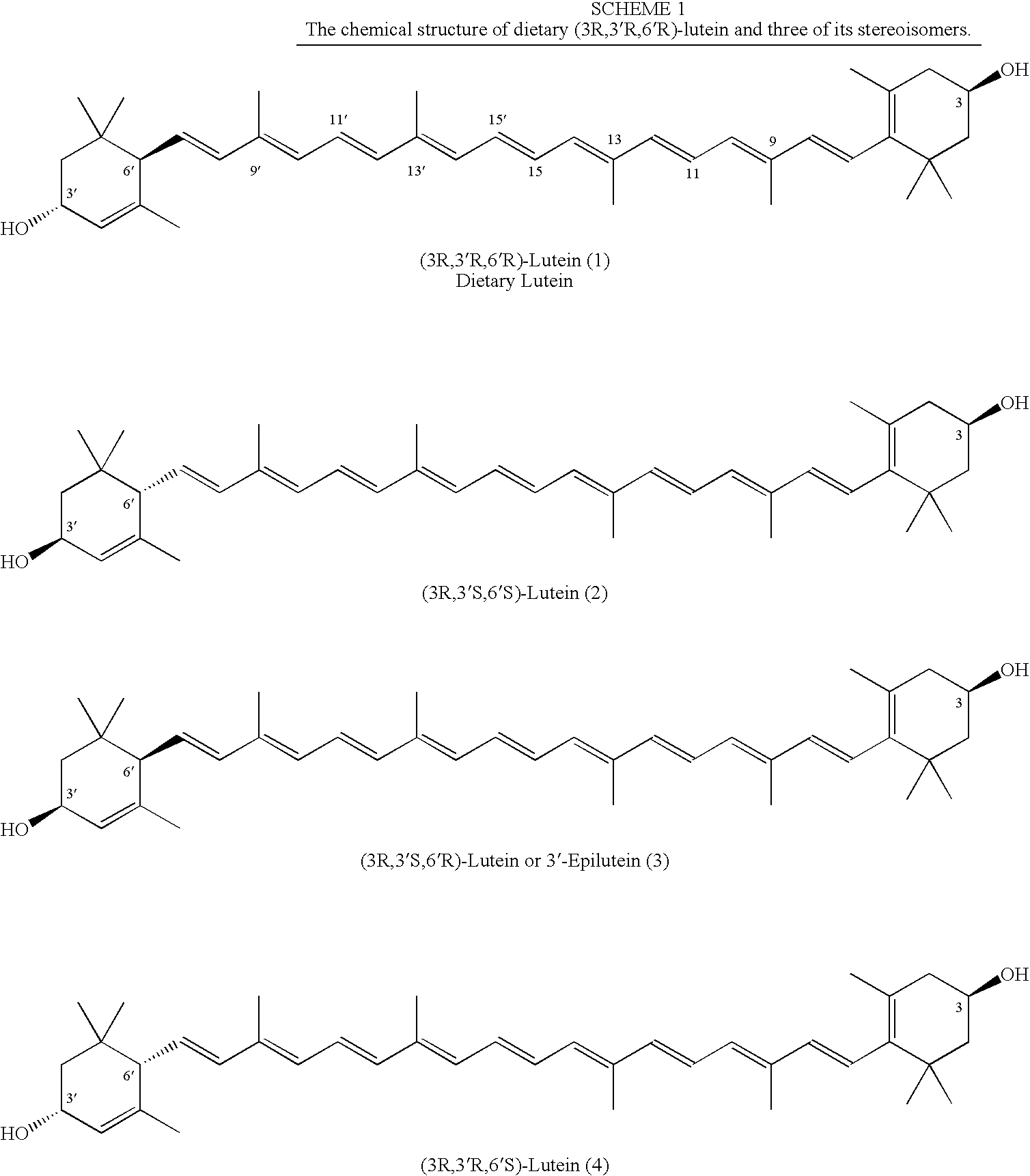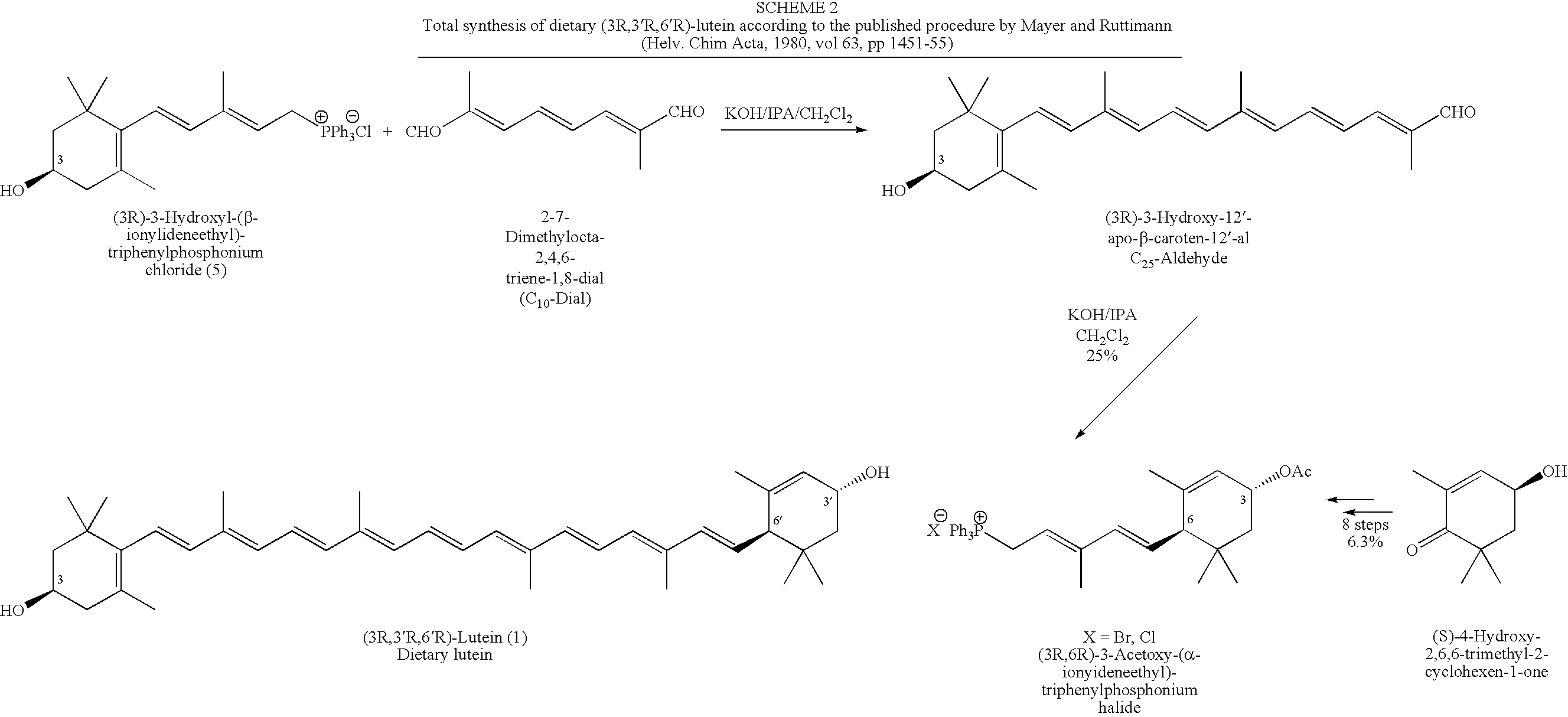Process for Synthesis of (3R,3'R,6'R)-Lutein and its Stereoisomers
a synthesis process and lutein technology, applied in the field of organic chemistry, can solve the problem that the building block has not been used in the synthesis of lutein or its precursors
- Summary
- Abstract
- Description
- Claims
- Application Information
AI Technical Summary
Benefits of technology
Problems solved by technology
Method used
Image
Examples
example 1
Synthesis of (rac)-α-Ionylideneacetonitrile (24a / 24b) (Route 1, Scheme 4)
[0079]Methanol (70 mL) was transferred into a 500 mL three-necked flask equipped with a nitrogen inlet, a thermometer, and an addition funnel. The flask was cooled down in an ice bath under N2 and sodium (5.47 g, 0.238 mol) washed with hexane, was added in small portions by maintaining the temperature below 10° C. After the sodium was completely dissolved, the solution was stirred at R.T. for 15 minutes and then cooled down to 0° C. A solution of diisopropyl cyanomethylphosphonate (47 g of 95% pure, 44.65 g, 0.218 mol) in TBME (20 mL) was added dropwise at 0-5° C. in 20 min. The ice bath was removed and the mixture was allowed to stir at R.T. for 1 h. The reaction mixture was cooled down in an ice bath and freshly distilled rac-α-ionone (38.10 g, 0.198 mol) in TBME (20 mL) was added dropwise in 45 min at 0-5° C. The mixture was allowed to warm up to room temperature and stirred for 4 h under N2. The product was...
example 2
Oxidation of (rac)-α-Ionylideneacetonitrile (24a / 24b) to (rac)-3-Keto-α-Ionylideneacetonitrile (23a / 23b) by Bleach and Aqueous TBHP
[0080](rac)-α-Ionylideneacetonitrile (13.15 g, 61.06 mmol) was transferred into a 500 mL three-necked flask using acetonitrile (30 mL, 23.58 g, 0.574 mol). K2CO3 (0.844 g, 6.11 mmol) was added and the mixture was cooled down in an ice-salt bath to 0° C. under N2. A 70% solution of TBHP in water (52 mL, 46.8 g 70% ≈32.76 g, 0.364 mol) was diluted with acetonitrile (21 mL, 16.51 g, 0.40 mol) and added dropwise to the mixture under N2 at 0° C. in 30 min. Household bleach containing 5.25% NaOCl (260 g, 13.65 g NaOCl, 0.183 mol) was then added over a period of 5 h at −5 to 0° C. After the addition was completed, the reaction mixture was stirred at 0° C. for an additional hour. The product was extracted with hexane (150 mL) and the organic layer was separated. The water layer was washed with hexane (2×100 mL) and the combined organic layer was washed with wate...
example 3
Palladium(II)-Mediated Oxidation of (rac)-α-Ionylideneacetonitrile (24a / 24b) to (rac)-3-Keto-α-Ionylideneacetonitrile (23a / 23b) with Anhydrous TBHP
[0081]A solution of (rac)-α-Ionylideneacetonitrile (19.60 g, 91.02 mmol) in dichloromethane (150 mL) in a 500 mL three-necked flask was cooled down in an ice-salt bath to 0° C. under N2 and was treated with K2CO3 (8.4 g, 60.78 mmol) and Pd / C (10 wt. % on C, 7.5 g˜0.75 g Pd, 7.05 mmol). A 5.5 M anhydrous solution of TBHP in decane (100 mL, 0.55 mol) was added to the mixture dropwise while maintaining the temperature at 0° C. The mixture was stirred for 36 h at 0° C. and 50 h at R.T. under N2. The solids were removed by filtration through celite and the filtrate was washed with water (3×150 mL), brine, and dried over Na2SO4. The solvent was removed under reduced pressure to give 24 g of a yellow oil. The crude product was purified by column chromatography (hexane:ethyl acetate, from 98:2 to 92:8) to yield a mixture of 23a and 23b (11.05 g, ...
PUM
| Property | Measurement | Unit |
|---|---|---|
| Temperature | aaaaa | aaaaa |
| Temperature | aaaaa | aaaaa |
| Temperature | aaaaa | aaaaa |
Abstract
Description
Claims
Application Information
 Login to View More
Login to View More - R&D
- Intellectual Property
- Life Sciences
- Materials
- Tech Scout
- Unparalleled Data Quality
- Higher Quality Content
- 60% Fewer Hallucinations
Browse by: Latest US Patents, China's latest patents, Technical Efficacy Thesaurus, Application Domain, Technology Topic, Popular Technical Reports.
© 2025 PatSnap. All rights reserved.Legal|Privacy policy|Modern Slavery Act Transparency Statement|Sitemap|About US| Contact US: help@patsnap.com



